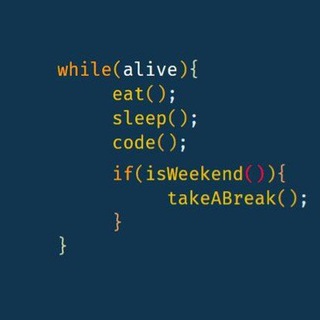How much DSA is enough to crack your dream job?
I get this question many times, so I'm sharing a roadmap that covers all the aspects:
https://www.linkedin.com/posts/rajatgajbhiye_how-much-dsa-is-enough-to-crack-your-dream-activity-7208687877990367233-M8nV?utm_source=share&utm_medium=member_android
Save this post ❤️
I get this question many times, so I'm sharing a roadmap that covers all the aspects:
https://www.linkedin.com/posts/rajatgajbhiye_how-much-dsa-is-enough-to-crack-your-dream-activity-7208687877990367233-M8nV?utm_source=share&utm_medium=member_android
Save this post ❤️
👍5
Software Engineers ❤️🙃
Microservices.pdf
What are Microservices? When and Why is it used? Monolithic vs Microservices Architecture
Microservices have become a hot topic in software development, promising agility, scalability, and faster deployments. But is it always the right path?
But before you dive in, let's see what makes them so awesome, and why sometimes, a simpler approach might be better.
What Are Microservices?
Microservices, simply put, are a way of designing software applications as a collection of small, independent services. Each service is responsible for a specific function or feature of the application, and they communicate with each other through APIs.
When and Why Are They Used?
Microservices are often used in large, complex applications where different parts of the system need to scale independently or be updated frequently. They offer benefits such as:
Agility: With microservices, teams can work on different services simultaneously, allowing for faster development cycles and quicker responses to changing requirements.
Scalability: Each service can be scaled independently based on demand, leading to better resource utilization and cost savings.
Resilience: If one service fails, it doesn't bring down the entire system. This isolation ensures that failures are contained and don't impact the overall application.
Monolithic vs. Microservices Architecture
In contrast to microservices, monolithic architecture involves building the entire application as a single, interconnected unit. While monolithic architecture is simpler to develop and deploy initially, it can become cumbersome to maintain and scale as the application grows.
When to Choose Which?
The decision between monolithic and microservices architecture depends on the specific needs and goals of your project:
Monolithic Architecture:
Ideal for smaller projects or when simplicity and ease of development are prioritized. It's a good starting point for projects with limited resources or tight deadlines.
Microservices Architecture:
Suited for large, complex applications with evolving requirements. It offers flexibility, scalability, and resilience, but comes with added complexity and overhead.
While microservices offer exciting benefits, they're not a one-size-fits-all solution. Consider your project's size, scope, and requirements carefully before deciding which architecture to adopt.
Microservices have become a hot topic in software development, promising agility, scalability, and faster deployments. But is it always the right path?
But before you dive in, let's see what makes them so awesome, and why sometimes, a simpler approach might be better.
What Are Microservices?
Microservices, simply put, are a way of designing software applications as a collection of small, independent services. Each service is responsible for a specific function or feature of the application, and they communicate with each other through APIs.
When and Why Are They Used?
Microservices are often used in large, complex applications where different parts of the system need to scale independently or be updated frequently. They offer benefits such as:
Agility: With microservices, teams can work on different services simultaneously, allowing for faster development cycles and quicker responses to changing requirements.
Scalability: Each service can be scaled independently based on demand, leading to better resource utilization and cost savings.
Resilience: If one service fails, it doesn't bring down the entire system. This isolation ensures that failures are contained and don't impact the overall application.
Monolithic vs. Microservices Architecture
In contrast to microservices, monolithic architecture involves building the entire application as a single, interconnected unit. While monolithic architecture is simpler to develop and deploy initially, it can become cumbersome to maintain and scale as the application grows.
When to Choose Which?
The decision between monolithic and microservices architecture depends on the specific needs and goals of your project:
Monolithic Architecture:
Ideal for smaller projects or when simplicity and ease of development are prioritized. It's a good starting point for projects with limited resources or tight deadlines.
Microservices Architecture:
Suited for large, complex applications with evolving requirements. It offers flexibility, scalability, and resilience, but comes with added complexity and overhead.
While microservices offer exciting benefits, they're not a one-size-fits-all solution. Consider your project's size, scope, and requirements carefully before deciding which architecture to adopt.
👍4❤3
Urban Company is hiring SDE-1
For 2024, 2023, 2022 grads
Expected CTC - 25LPA
https://careers.urbancompany.com/jobDetail?id=9af0656f-fad3-421a-802e-caf1591f8a4f
✅💯
For 2024, 2023, 2022 grads
Expected CTC - 25LPA
https://careers.urbancompany.com/jobDetail?id=9af0656f-fad3-421a-802e-caf1591f8a4f
✅💯
👍2❤1
I often get asked about which MERN stack projects to work on. Here’s a list of free projects that cover all the essential aspects:
https://www.linkedin.com/posts/rajatgajbhiye_mern-mernprojects-react-activity-7209050014201872384-U2qT?utm_source=share&utm_medium=member_android
Save this post ❤️
Share with your friends ✅
https://www.linkedin.com/posts/rajatgajbhiye_mern-mernprojects-react-activity-7209050014201872384-U2qT?utm_source=share&utm_medium=member_android
Save this post ❤️
Share with your friends ✅
👍1
Software Engineers ❤️🙃
Java Technical Interview Questions.pdf
Many people have messaged me to post questions related to Java.
So, Here are some commonly asked Java Technical round questions to help you ace your interview!
Stay curious, keep learning, keep sharing!
So, Here are some commonly asked Java Technical round questions to help you ace your interview!
Stay curious, keep learning, keep sharing!
👍2
DSA is really tough, but you don't seem to struggle?
I get this question a lot.
Here are some of the hardest questions you might face in an interview.
https://www.linkedin.com/posts/rajatgajbhiye_dsa-datastructures-algorithm-activity-7209774286494982145-TcQU?utm_source=share&utm_medium=member_android
I have shared some tips to solve any DSA problem and how we can remember it.
Stay curious, keep learning, keep sharing!
I get this question a lot.
Here are some of the hardest questions you might face in an interview.
https://www.linkedin.com/posts/rajatgajbhiye_dsa-datastructures-algorithm-activity-7209774286494982145-TcQU?utm_source=share&utm_medium=member_android
I have shared some tips to solve any DSA problem and how we can remember it.
Stay curious, keep learning, keep sharing!
❤2
Dependency Injection in Java
This is the frequently asked Interview Question
https://www.linkedin.com/posts/rajatgajbhiye_java-dependencyinjection-activity-7210136970780438529-K2hs?utm_source=share&utm_medium=member_android
Keep learning ❤️
This is the frequently asked Interview Question
https://www.linkedin.com/posts/rajatgajbhiye_java-dependencyinjection-activity-7210136970780438529-K2hs?utm_source=share&utm_medium=member_android
Keep learning ❤️
❤3
DSA is so easy when you follow these 6 steps
1. Focus on Depth over Breadth
2. Create a list of key questions
3. Master each data structure
4. Practice with Spaced Repetition
5. Identify reusable techniques and code blocks
6. Expand into breadth
https://www.linkedin.com/posts/rajatgajbhiye_dsa-datastructures-softwareengineering-activity-7210499339138306048-Nj3x?utm_source=share&utm_medium=member_android
Save the post❤️
1. Focus on Depth over Breadth
2. Create a list of key questions
3. Master each data structure
4. Practice with Spaced Repetition
5. Identify reusable techniques and code blocks
6. Expand into breadth
https://www.linkedin.com/posts/rajatgajbhiye_dsa-datastructures-softwareengineering-activity-7210499339138306048-Nj3x?utm_source=share&utm_medium=member_android
Save the post❤️
👍4❤3

